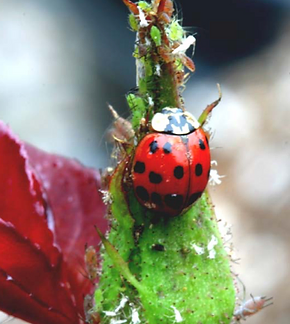by Rich Baer, Master Rosarian, Portland Rose Society
Growing beautiful gardens is always a challenge. If you have one problem and you can figure out a way to get around it another one is sure to show up. I have often said that I find destructive insects in the rose garden to be an exceedingly small problem. One of the reasons for this is that nature maintains a balance if you let it, usually. Well maybe not for Grasshoppers and Cicadas which are in the news this week but not in our area. Sometimes other garden invaders can also become a problem which requires intervention to keep the damage to a reasonable amount.
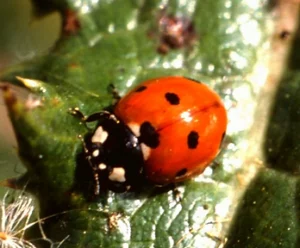
When asked about bothersome insects the most common answer from rose gardeners is aphids. They are common in my garden but not usually to the extent that I feel that I must intervene. When asked what I do about them I generally say that I turn my back on them and wait two weeks by which time I usually find that they are no longer a problem. One of several reasons for this occurrence is the presence of ladybeetles in my garden. First, lets look at their name. If you are a taxonomist or entomologist you would have to call our most common ones Hippodamia convergens. In the insect world they are in the family Coccinellidae and are Coleoptera, which are called beetles. That is a lot of name for a small insect so the more common name has evolved. Originally the name “ladybeetle” was coined by European farmers who prayed to the Virgin Mary when pests began eating their crops. After ladybeetles came and wiped out the invading insects, the farmers named them “beetle of Our Lady.” This eventually was shortened to “lady beetle” and “ladybeetle.” NASA even sent a few ladybeetles into space with aphids to see how aphids would escape in zero gravity.
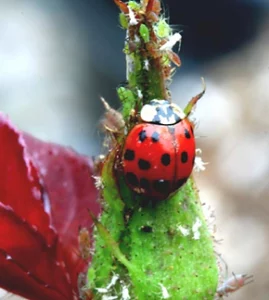
Adult lady beetles have very characteristic convex, hemispherical to oval shaped bodies that can be yellow, pink, orange, red, or black, and usually are marked with distinct spots. This is a type of warning coloration to discourage other animals that may try to eat them. Like many other brightly-colored insects, they are protected by an odorous, noxious fluid that seeps out of their joints when the insects are disturbed. The bright body coloration helps some predators to remember the encounter and avoid attacking insects with similar markings.
Ladybeetles appear early in the year in the garden. Often they are one of the first insects that you will notice in the garden. They appear early because in the fall the adults find a sheltered area and hibernate. Sometimes that sheltered area maybe inside your home, but usually it among the detritus in the garden. They are known to congregate at hibernation time into exceptionally large groups. These groups are the insects that are often harvested and offered for sale as garden predators. When the weather warms the adults leave the hibernation state and appear in the garden looking for food. Early in the year that food usually consists of aphids which also appear early in the rose garden.

When the adults have fed for awhile on the early aphids the next phase of their life is to reproduce. I have read that the adults find each other through the presence of pheromones. These are scents produced by one ladybeetle that is sensed by another ladybeetle to enable them to get together. I have witnessed a lot of ladybeetle mating through the years in my garden and it seems that they are indiscriminate in finding mates that look like they do. So it appears that the different varieties of ladybeetles found in your garden are all sexually compatible. After mating the female will lay eggs almost immediately or up to three months later. The eggs are almost always located on the lower sides of the leaves where the adults have found food, aka aphids. The normal clutch of eggs is between ten and 50 at a time, but an adult female ladybeetle can lay up to 1,000 eggs in her lifetime.The eggs are usually laid on the bottom of leaves, in our garden it is on the bottom of rose leaves. When normally walking through the garden you would not notice them as they are not very large. However, when any pruning is done I always turn the stem over so that I can look at the bottoms of the leaves.
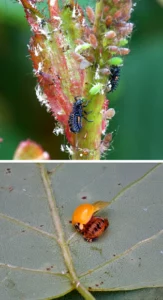
On an average day I will see a number of egg clutches. When I spot one, I cut the leaf off and tuck it back onto the bush so the eggs will get the chance to hatch on the bush. They would hatch in the garbage can, but they would not be likely to live if they did that. I have looked at a lot of insect eggs over the years and there is no other insect that lays eggs that look like or could be confused with those of the Ladybeetle. So when you encounter them you should try to make sure that they have a future in your garden where they can carry out their major life function, feed and grow into adults. Within a few days the eggs will begin hatching. The newly hatched lady bug larvae certainly bear no resemblance to the adult insects they will become. The picture on the right shows the tiny larvae as they are emerging from what are now the white egg cases. They will soon crawl around the rosebush looking for small insects to eat. The adults insects usually pick a place in the garden to lay their eggs where there is a good supply of food. This food will be readily found by the larvae and they begin eating it.
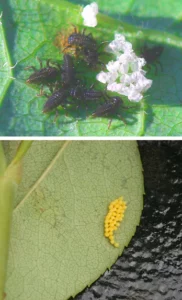
The newly hatched larvae will eat the smallest of the aphids they find and they will change their looks slightly by growing some orange markings on their backs. If food is plentiful the larvae eat lots of and grow rapidly through four larvae stages called instars shedding their skins between stages. If the food in plentiful the larva grow quickly while devouring between 350 and 400 aphids each. This leads to the formation of the large ladybeetles you see in the garden. If food is scarce the larvae continue to eat what they can find but they do not grow as fast or as large. The adults resulting from these larvae tend to be quite a bit small than the largest ones. When the larva mature after the fourth stage they pupate. What this entails is that the mature lady bug larva attaches itself to the plant by its abdomen. It remains still during the pupae stage which can last from seven to fifteen days. During this time the genetics of the insect break down the larva body and rebuild it to the adult ladybeetle, quite a remarkable achievement. When the pupation period is over the pupa splits down the back and the new adult ladybeetle emerges. The new adults are generally yellow in color and their bodies are soft. Soon after hatching the ladybeetle body firms up, The shell becomes hard and the bright colors we associate with ladybeetles appear. Their Bright coloring may be an example of aposematosis, in which the bright colors warn predators of toxicity and/or bad taste. Also, female adults can reflex bleed from leg joints. The blood (hemolymph) has a repulsive smell that can fend off predators such as small birds and lizards.
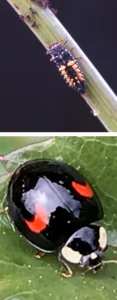
We have a lot of different colored lady bugs in our area and you should be on the lookout for various ones in your garden just for your enjoyment of nature. My favorite is the one pictured to the right which is called the twice stabbed ladybeetle. Although not an actually ladybeetle it is closely related and has the same life style, garden predator with an affinity for aphids and other small insects including scale insects. It however is an insect that brings back some interesting memories. When I worked at Edmunds roses I usually got to deal with customers who wanted to know about certain insects. Their description of the insect of the day usually began with, they look like an alien. Since I have never seen an alien that never helped much. However, the only insect that I was ever sure of a positive identification was one described as a small black insect with two red spots. I was sure I knew what the lady had. After we talked for awhile, she said it really did not matter what the insect was, because she had sprayed them with Orthene and it killed all of them. Sometimes a little knowledge would be worth a lot.

